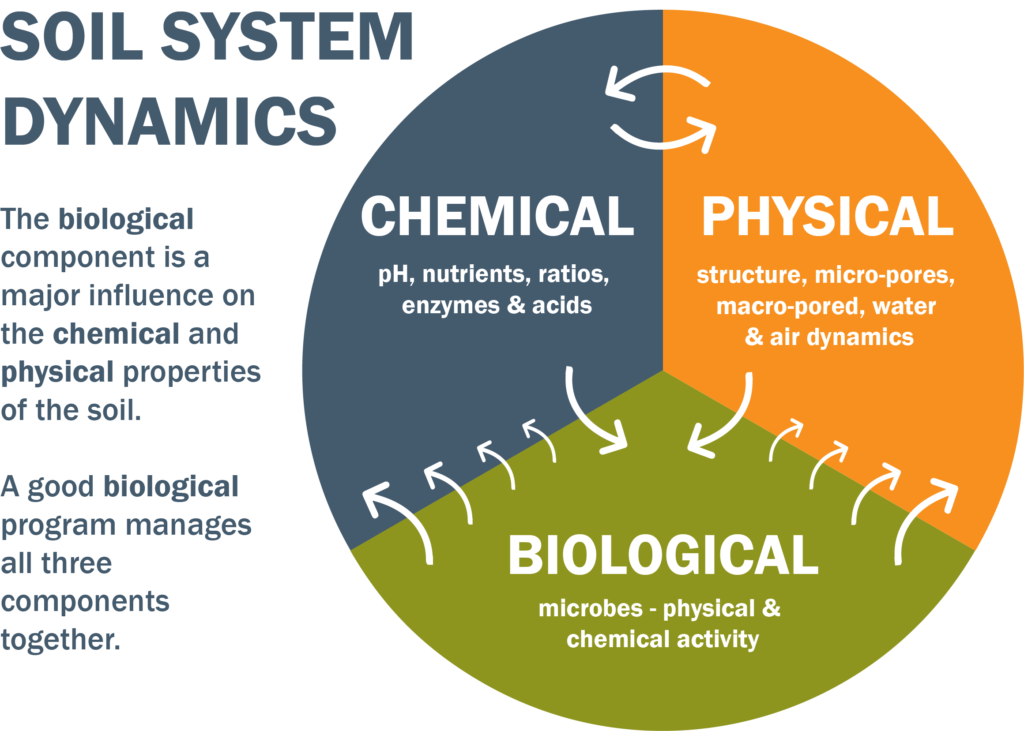In a healthy state, the soil is a living, dynamic ecological system that maintains homeostasis (a term used to describe a relatively constant internal environment despite external change). This ability and condition is most conducive for healthy soils, healthy plants and healthy life to flourish. We need to understand the intricacies of our soils and see that nature has already designed an excellent system if we work with it..
The three basic themes help us to understand how the soil works and should be managed:
- The soil is the stomach for the plant. If we apply inputs that are likely to upset this digestive system, we compromise the plants ability to absorb nutrition effectively.
- Soil organisms or soil life are the ‘biological machinery’ that drive complete plant fertility
- The soil is an interrelated system of chemical, physical and biological properties, each expressing influence on the other.
Unfortunately, due to trends that have been established in agriculture and pressures on the industry, there has been more of a focus on producing an end product rather than an emphasis on farming our soils. It appears as though fundamental fertilisation practices and the resulting soil degradation are part of the problem.

Above: A root system colonised by a Mycorrhizai fungus. In a symbolic relationship, the fungus disolves nutrients in the soil and ferries them to the plant, in return for plant sugars.
Most of the commonly used fertilisers in agriculture are highly soluble and saltbased (N,P,K, Ca, Mg, Zn etc salts). These generally contain sulphates and nitrates that are very reactive and very leachable in the soil. They react with minor trace elements to form leachable salts. Water percolation can then easily strip these valuable nutrients from the profile and they are often not replaced in most conventional soluble-fertiliser based programs.
These fertilisers are generally acidic, and also strip alkalising minerals such as calcium and magnesium from the top soil. Some minerals, such as selenium, molybdenum and magnesium can only be taken up by the plant when the soil is near neutral, so even if they are in the soil profile, the plant cannot access them in acid conditions (Hungerford C 2009). Although NPK acid salt fertilisers have delivered big yields, their use comes at a cost to soil health.
What affects nutrient availability?
Applying high levels of soluble salt fertiliser to the soil system also cripples the beneficial living component … the micro and macro fauna of the soil. These organisms are in essence the ‘biological machinery’ of the soil that drive soil health and fertility. Fertilisers with a high salt index shut down many biological pathways used by plants to gain nutrition.
The key is to employ fertilising techniques that aim to maintain healthy soil chemistry at the same time as enhancing and nurturing the soil organisms.
It is the soil organisms that digest, cycle and deliver the correct nutrition at the correct time to the plant. Mycorrhizal fungi, for example, source phosphorus for the plant in a symbiotic relationship and have also been linked through CSIRO research to the uptake of zinc.Once colonised, the fungus and plant are in constant communication regarding nutritional requirements.
Mycorrhizal fungi colonise roots of plants and send out hyphae filaments into the soil profile, accessing between 100 to 1000 times the soil volume than the plant roots alone can access (see insert picture). These important organisms are discouraged or ‘switched off’ by high levels of available phosphorus applied as acid treated fertiliser thus impacting the availability and uptake of both phosphorus and zinc in the plant.
In a similar fashion, nitrogen fixing bacteria are ‘switched-off’ by high levels of free nitrate nitrogen, shutting down the pathway plants use naturally to access nitrogen. Once the soil is biologically and chemically ‘out of balance’, we lose all sorts of fertility benefits delivered by healthy soil ecology. Disease organisms often proliferate in these conditions.

So how do we fertilise for maximum nutrition and soil health?
We need to include in our fertility programs fertilisers that contain a wide range of minerals in their analysis, and also enhance microbial activity in the soil. Mineral fertilisers (from basalt or volcanic origin), ocean based fertilisers (kelp and fish) and ancient plant deposits such as peats and leonardites (humates) are such fertilisers.
These materials contain all of the minerals that sustain life, including all the micro nutrients that are often required in very small quantities, but are hugely important to plant metabolic health and nutritional value of that plant.
If there is a need to solve major nutritional deficiencies in certain soils, where possible we need to be applying non-salt forms of the nutrient and allow the soil biology to digest and release the nutrition through natural means.
Soft rock phosphate, calcium and magnesium carbonates, and basalts are such inputs. However, where a quick result is an economic imperative and acid treated or soluble salt fertilisers are required (urea, DAP, MAP, super, gypsum), these inputs should always be kept to a minimum and preferably be buffered with a carbon source to render them more soil friendly, and also more efficient to the plant.
It is a very basic notion that we are what we eat, and this all starts with the soil and how we manage it.
References Good Health in the 21st Century, Dr Carole Hungerford, Scribe Publications PtyLtd Carlton Nth VIC.
For further information, please contact AgSolutions® on 1800 81 57 57.
